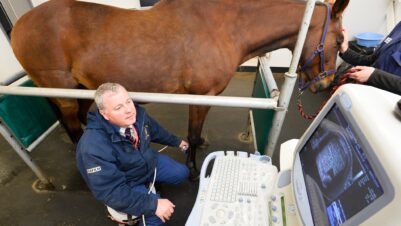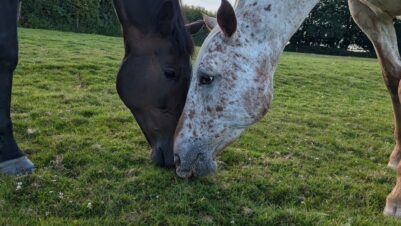The latest MSD FlockCheck 2025 data shows persistently high levels of exposure to toxoplasmosis and enzootic abortion (EAE) in UK flocks. Despite the availability of effective vaccines such as Toxovax and Enzovax, 2025 diagnostic results from almost 400 farms reveal:
- Seventy-nine percent of tested flocks showed exposure to Toxoplasma gondii
- Thirty-five percent tested positive for exposure to Chlamydia abortus, the cause of enzootic abortion
Both diseases are classified as NOAH Category 1 diseases, meaning vaccination should be considered standard practice on all sheep farms. Yet, recent farmer MSD survey data reveals that more than 60 percent of flocks are not routinely vaccinated against either disease.
Veterinary surgeon Sarah Smith from the George Veterinary Group in Wiltshire is urging farmers to assess their abortion history and lamb losses now and consider vaccinating at-risk stock at least four weeks before tupping to ensure immunity is established before mating begins.
“These are preventable diseases that can cause devastating losses. Yet many farmers don’t realise they’ve had an issue because losses go unrecorded or unexplained,” said Sarah.
“Now is the critical window for action. If you’ve had barren rates or abortions losses over 2 percent or poor lamb numbers last season, speak to your vet, investigate potential causes and depending on test results, plan to vaccinate. Waiting until the autumn may be too late.”
Lack of monitoring hampers progress
Data from MSD Animal Health’s Flock Health Checklist Survey, completed by over 960 sheep farmers in 2024, also highlights a worrying lack of basic performance recording and disease investigation:
- Forty-two percent of farmers don’t know their lamb loss rate
- Thirty-one percent don’t know their ewe barren rate
- Thirty-three percent of respondents don’t investigate abortions
- Sixty-two percent don’t vaccinate for enzootic abortion or toxoplasmosis
Worryingly, 69 percent of farmers with open flocks who didn’t vaccinate reported lamb losses of over 15 percent or said they didn’t know their loss rate, compared with 55 percent among those who did vaccinate or ran closed, monitored flocks.
Sarah believes simple improvements in data recording could drive progress across the sector: “Some farmers use EID and handheld readers; others use a notebook. Both work – what matters is capturing the information and reviewing it regularly with your vet.”
Dr Kat Baxter-Smith, veterinary adviser with MSD Animal Health, says the figures from the Flock Health Checklist Survey show a clear pattern: “Vaccination and monitoring go hand in hand. Farmers who track their performance and take action, such as vaccinating for infectious abortion, consistently report lower lamb losses and fewer problems.
“It’s frustrating to still see so many farmers dealing with avoidable losses when the tools are available.”
Know your risk – and act accordingly
Sarah says that this summer it’s vital for farmers to take a risk-based approach to abortion vaccination by considering their flock status and exposure risks, particularly if they are buying in replacements or have previously experienced high barren rates or lamb losses.
However, unless barren and abortion rates are below 2 percent or a flock is fully closed, then ewe vaccination should be considered.
“If disease is present in the flock or you are buying in from flocks of unknown status, the cost of vaccination can easily be offset by reducing future barren rates and abortion losses. Non-pregnant ewes can be vaccinated anytime up until four weeks prior to tupping, but there’s no need to wait that late, with the summer providing an ideal opportunity to vaccinate,” she added.
“Speak with your vet, review lamb losses and ewe barren rates, and if your flock is at risk – vaccinate.”
Sarah appreciates that some of the breeding ewe sales are quite late in the season, not leaving enough time for vaccination ahead of mating. Where this is the case, she recommends keeping them separate from the flock for a whole breeding season, only introducing them after lambing in 2026.
“Introducing enzootic abortion into a naïve flock could cause a big problem next spring with losses,” she said.
The good news is that both vaccines provide long-lasting protection – enzootic abortion vaccination Enzovax is only needed every 3 to 4 years. Vaccination with Toxovax is known to protect for at least two lambing seasons.
“That means once you’re on top of it, the long-term management is straightforward,” she said.
She also encourages farmers to consider bluetongue vaccination this summer – with the disease known to lead to high rates of mortality and abortion in sheep, as well as fertility issues in rams.
Support through funded vet visits
Farmers in England are encouraged to make the most of the Animal Health and Welfare Pathway, which offers funded annual vet visits to support health planning and identify endemic disease risks.
“This is a fantastic opportunity to sit down with your vet, review performance, and plan your health strategy before tupping. Don’t let another season go by without doing something,” said Sarah.
Key actions ahead of tupping:
- Book vaccinations now – at least 4 week before tupping
- Review 2025 lamb losses, barren rates, and any signs of abortion
- Investigate past problems using diagnostics such as FlockCheck subsidised by MSD Animal Health (now closed for 2025)
- Speak to your vet about your risk level and vaccination needs
- Use funded vet visits under the Animal Health and Welfare Pathway






